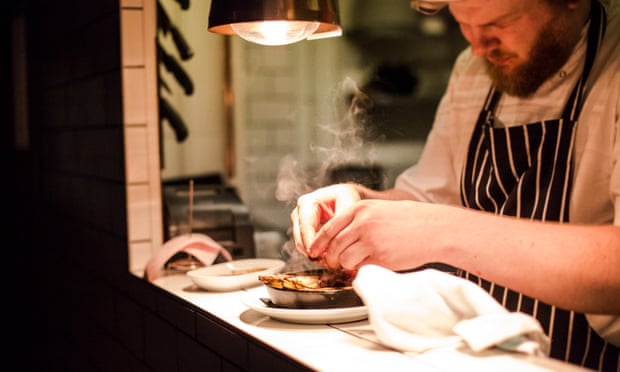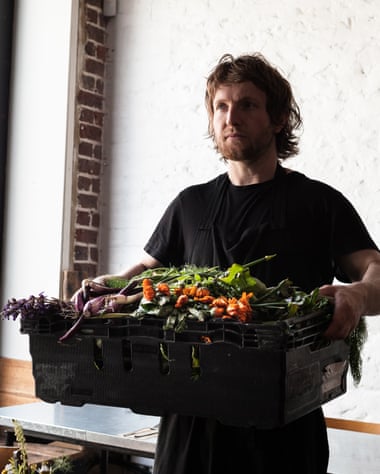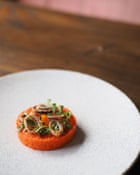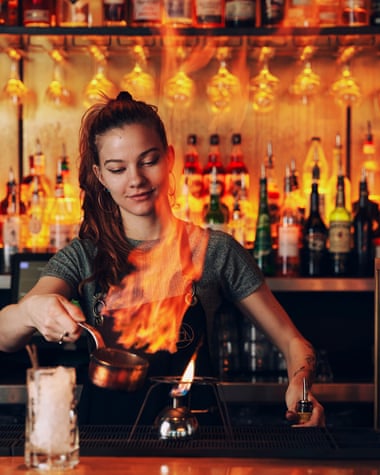Short menus, local produce, no tablecloth: how to choose a restaurant and help save the planet | Food
The doors of good restaurants frequently display stickers from guidebooks such as Michelin or the Good Food Guide. It is far less common to spot anything that proclaims their green credentials. Even venues making positive moves on sustainability can be coy about flagging it, for fear of boring people.
Consequently, diners who are keen to make better choices for the planet in where and how they eat lack direction. You need to know how to decode a restaurant and its menu, spotting the tell-tale signs of a progressive operation. What marks out a greener restaurant and what should we order when we get there? How, as customers, can we embrace that change?

Do a little digging
It will seem archaic to those swiping through dishes on TikTok and Instagram, but a restaurant website will, in a few clicks, yield useful intel easily missed on social media. You might find out, for example, that a restaurant uses green energy (Maray in Liverpool), or upholsters its chairs in the pineapple-skin leather alternative, Pinatex (Pizza Pilgrim’s eco test-site at Selfridges, London).
Some schemes do exist to ethically audit restaurants. It may only currently cover 3,000 of the UK’s near 90,000 restaurants, cafes and takeaways, but the Sustainable Restaurant Association’s Food Made Good star ratings are available at foodmadegood.org. Living Wage Foundation-accredited hospitality venues (sustainability includes people, too, right?), can also be browsed by region at livingwage.org.uk. One such restaurant, Manchester’s Open Kitchen, is, says its founder, Corin Bell, proof that “you can run a business without killing the planet or treating people badly”.
Menu (and portion) size matters
Think about the style of the restaurant. Broadly, the larger the menu the more food waste it will likely generate. According to the campaigning charity WRAP, 21% of the £3.2bn of food wasted annually in UK hospitality comes from ingredient spoilage. “A la carte restaurants walk a tightrope between selling out [of dishes] and having excess thrown away. It is rare they know how many people are going to turn up, what they will order and when,” says chef Alex Rushmer.
Choose a restaurant with a shorter menu and you curb that tendency. Choose one with a set menu, like Rushmer’s plant-based Vanderlye in Cambridge, and the kitchen should produce minimal waste.
Some research suggests larger menus encourage over-ordering, with food going uneaten (plate-waste constitutes 34% of binned restaurant food). Carbs such as chips, bread and rice, baked beans on full breakfasts and frou-frou salad garnishes on sandwiches, are often left. Simply serving smaller portions, says WRAP, can lead to significant waste reduction.
“Be mindful of servers who push you towards more food than you can eat,” warns Sustainable Restaurant Association managing director, Juliane Caillouette Noble. If you do over-order, don’t be shy about asking to take leftovers home.
Manchester’s Common bar switched from a brunchy menu (“Loads of burgers. Avocado-use was insane,” says the owner, Jonny Heyes), to serving its meat-minimal Nell’s Pizza. One reason was because pizza – and these run to a whopping 22in – is a dish that: “If people don’t finish it, give them a box and they’ll take it home. There’s not many products people would do that with.”
No-shows are not on
Kitchens order according to predicted numbers of (booked) diners and every no-show, as well as being financially damaging, is likely to result in more fresh ingredients thrown away.

Save paper, embrace technology
Years ago, when restaurants started putting menus and wine lists on tablet computers, it seemed gimmicky. Mid-2020, clunky online ordering systems had people crying into their (empty, socially-distanced) pints. But the pandemic urgency to improve that technology means it is now frequently seamless to access a menu via QR code and order on your phone – rather than, particularly in food halls, multiple venues printing endless paper menus.
Even ordering face-to-face, do you need a paper menu? In country pubs, chalkboard menus pre-date the climate crisis. At Silo, a “zero-waste” London restaurant, the menu is projected on to the wall. “It works like a dream and uses less energy than a few lightbulbs,” says chef-owner Douglas McMaster.
At Apricity, in London, owner Chantelle Nicholson has encountered “some pushback” after asking guests to look at the menu on their phones (a larger tablet is available for customers who find that easier). But having moved the menu online to save paper, Nicholson has been struck by how it allows the kitchen to quickly update the menu, minimising waste. Rather than being held to a menu printed for that service, she says: “If we have three pork belly portions left, we can sell these, then switch to another dish.”
At the other end of the meal, Maray has dispensed with paper bills and receipts because the thermal paper used to print them is not ordinarily recyclable. Diners view the bill on a handheld terminal and are emailed a receipt.

Rethinking creature comforts
The absence of tablecloths is not just a question of style. It removes, says Rushmer, an “overlooked” contributor to a restaurant’s carbon footprint. “It’s common for laundry to be collected by a dedicated company, washed, starched, pressed, potentially wrapped in single-use plastic and delivered back.”
Going further, Cardiff’s Kindle restaurant has nixed napkins which, says co-owner Deb Lewis, are “invariably” left untouched, but “must be laundered regardless”. Like throwing away disposable paper napkins, that felt wasteful. A stash is held for messy dishes, emergencies or guests who really need one, but, says Lewis, after some initial “shock and horror”, most diners accept the no-napkin policy.
Despite being an entirely alfresco venue, Kindle does not use outdoor heaters, either. Many restaurants will follow suit this winter due to rising energy prices. “Heating the outdoors is a losing, unsustainable battle,” says Lewis. Diners are offered blankets and hot water bottles. If need be, regulars wear big coats: “We’ve had people turn up in ski suits. It’s all part of the experience.”
Upcycled, reusable spaces
From refurbished furniture and bars built from scaffolding planks (Café Spice Namasté, London) to lampshades created from the fungus mycelium (Silo), a growing minority of restaurants are building green principles into their interior design. Apricity and Kindle are so-called restorative or regenerative builds, meaning everything, from Kindle’s motion-sensor LED lights to the wool insulation in the kitchen (built into a former park warden’s cottage), can be removed and re-used.
Pickling and fermenting is not just a hipster fad. When playing “amateur sleuth” online, chef Matthew Pennington, co-owner of the Ethicurean, near Bristol, sees references to preserving techniques on menus as a sign of good habits. The kitchen that pickles excess produce in summer is, in winter, says Pennington, “less likely to order out-of-season kit from leagues away. It shows they take care in minimising waste.”

Does the menu set vegetables in the foreground? Kindle aims for 70% veggie dishes. Are low-impact wild meats used? For example, Forestry England is urging people to eat wild venison. It must cull exploding deer numbers for environmental reasons and otherwise, what it describes as, “arguably the UK’s most sustainable meat”, will go to waste, a spokesperson says.
It is pretty rare on menus, but you could make a similar case for British, RSPCA Assured rose veal, which is produced to higher welfare standards than its EU equivalent. The RSPCA says: “Sadly, the vast majority of unwanted dairy bull calves are shot at birth as there isn’t currently enough of a market for all of them to be reared as veal.”
A good menu should also be transparent and verifiable. Where fish and seafood are offered, does the menu include the Marine Stewardship Council [MSC] blue eco-label? Are suppliers named? Are claims to nose-to-tail, root-to-shoot, fin-to-gill cooking backed up by visible instances of such cooking? Does the menu include, for example, no-waste pesto made from carrot tops, potato and Jerusalem artichoke peel crisps, or seasonings of salted spring onion ash?
Sourcing and what it says about a restaurant
Given how little transport contributes to food’s carbon footprint, particularly that of the most emission-generating foods such as red meat or dairy, the “eat local” mantra is outdated. What you eat and how it was produced matters more than where it came from (caveat: sustainability is complex, there are always exceptions).
However, restaurants that grow their own or rely on a few small, regional suppliers are usually set up that way because the chef wants to use heritage ingredients cultivated using regenerative, low-impact or organic farming methods. It is a sign of good intentions, even if the head chef is primarily concerned with flavour and ingredient quality, rather than the planet.
What should you eat?
Vegetables, as repeated studies have shown. But non-vegans can change how they order in meaningful ways. To take pressure off stocks, George Clark, the MSC programme director, urges diners to eat seafood other than the popular big five: cod, haddock, salmon, tuna, prawns.
He recommends (in summer) Cornish sardines and herring as replacements for salmon and tuna in sushi, or hake and coley as “versatile” alternatives to cod and haddock. Look for restaurants embracing that advice. UK and Irish mussels, adds Clark, are “low-impact, carbon sequesterers” that, particularly when rope-grown, “positively impact the environment and marine ecosystem”.
Rather than awkwardly quizzing your waiter, consulting the Marine Conservation Society’s [MCS] Good Fish Guide app is a useful way to stay up to date with which seafood to avoid. Its red list includes European eel which, says Jack Clarke, the MCS sustainable seafood advocate, “is often found on fine dining menus but is more endangered than a panda”.
Eating prime cuts of chicken, pork, lamb and beef (listed in ascending order of their greenhouse gas emissions, according to Our World In Data analysis), leaves a lot of squidgy offal potentially uneaten. One German study suggested that eating more heart, liver and kidney could reduce livestock emissions by 14%, as fewer animals would need to be reared overall.
Such eco-conscious dining may require a gastronomic leap of faith. Kindle’s barbecued lamb heart with smoked breast meat, fermented red cabbage, triple-cooked lamb-fat fries, chilli, garlic and mint sauce, is, admits Lewis, “pushing boundaries”. Offal always is. Equally, it contains “all the flavours people know from a great kebab”.

Booze without a planet-sized hangover?
If you cannot stick to tap water, drink local pints. Packaging beer in glass bottles or cans and moving that heavy liquid long distances is a relatively significant contributor to its overall carbon footprint (even before you start recycling that packaging), and one that it is fairly easy to address if you drink draught beer. The metal kegs and casks used for draught beer last decades and, if you are drinking locally brewed beer, may travel only a few miles.
Cellar-cooled rather than refrigerated, cask real ales produce less CO2 than lager, according to one Imperial College London study, while traditional cider (heat-free fermentation, British ingredients from bio-diverse orchards), is often touted as the greenest booze.
Those weighty issues around glass and transport have led to a rise in tap wine, served from recyclable kegs. Simultaneously, so-called low-intervention or natural wines, made from biodynamic or organically farmed grapes (no pesticides, no monoculture soil degradation) have surged in popularity. As Steve Nuttall, founder of the Leeds bar-shop Wayward Wines, puts it, this is “wine made with respect for the land”.
There is now a number of British low-intervention winemakers, such as Ancre Hill, Tillingham and Davenport. Like the organic, biomass-boiler-powered whisky distillery, Nc’nean, the Scottish carbon-positive pea gin, Nàdar, or 58 and Co, which makes a pink gin using renewable energy and “wonky” apples, these brands are pioneering a greener future for booze. Toast Ale, made from surplus bread, regularly appears on menus nationally, and several other breweries are creating beers from potential waste products. Seven Brothers’ Throw Away IPA, brewed in Salford, uses breakfast cereal offcuts from the nearby Kellogg’s.
The age of cocktails extravagantly decorated with fruit that often goes uneaten is passing. In December, the Revolution chain dropped the passion fruit garnish that used to float in its pornstar martini. Now the talk is of closed-loop cocktails which, in cordials, syrups and infused spirits, use every part of the fruit, not just the juice. The bar-restaurant chain, the Alchemist, creates “marmalade” from discarded citrus peel to use in a spritzer and a martini on the brunch menu.
Look out for homemade ingredients, seasonal foraged or preserved garnishes and batched cocktails which – chilled rather than shaken over ice – can decrease the amount of water wasted by bars. We can all drink to that.